 W
WA mechanical puzzle is a puzzle presented as a set of mechanically interlinked pieces in which the solution is to manipulate the whole object or parts of it. One of the most well-known mechanical puzzles is the Rubik's Cube, invented by the Hungarian architect Ernő Rubik in 1974. The puzzles are mostly designed for a single player where the goal is for the player to see through the principle of the object, not so much that they accidentally come up with the right solution through trial and error. With this in mind, they are often used as an intelligence test or in problem solving training.
 W
WThe 15 puzzle is a sliding puzzle having 15 square tiles numbered 1–15 in a frame that is 4 tiles high and 4 tiles wide, leaving one unoccupied tile position. Tiles in the same row or column of the open position can be moved by sliding them horizontally or vertically, respectively. The goal of the puzzle is to place the tiles in numerical order.
 W
WAlexander's Star is a puzzle similar to the Rubik's Cube, in the shape of a great dodecahedron.
 W
WAltekruse Puzzle is a type of burr puzzle invented by Austrian inventor William Altekruse.
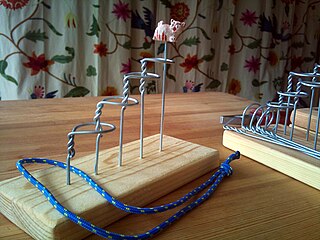 W
WBaguenaudier, also known as the Chinese rings, Cardan's suspension, Cardano's rings, Devil's needle or five pillars puzzle, is a disentanglement puzzle featuring a loop which must be disentangled from a sequence of rings on interlinked pillars. The loop can be either string or a rigid structure.
 W
WA burr puzzle is an interlocking puzzle consisting of notched sticks, combined to make one three-dimensional, usually symmetrical unit. These puzzles are traditionally made of wood, but versions made of plastic or metal can also be found. Quality burr puzzles are usually precision-made for easy sliding and accurate fitting of the pieces. In recent years the definition of "burr" is expanding, as puzzle designers use this name for puzzles not necessarily of stick-based pieces.
 W
WA Chinese puzzle ball, sometimes known as a devil's work ball, is a Chinese-made artifact that consists of a number of intricately carved concentric hollow spheres carved from a single solid block that fit within one another in a way that looks impossible. They were traditionally made of ivory. Following the international ban on the ivory trade, manufacturers of puzzle balls have tried using other materials, including bone.
 W
WA combination puzzle, also known as a sequential move puzzle, is a puzzle which consists of a set of pieces which can be manipulated into different combinations by a group of operations. Many such puzzles are mechanical puzzles of polyhedral shape, consisting of multiple layers of pieces along each axis which can rotate independently of each other. Collectively known as twisty puzzles, the archetype of this kind of puzzle is the Rubik's Cube. Each rotating side is usually marked with different colours, intended to be scrambled, then 'solved' by a sequence of moves that sort the facets by colour. As a generalisation, combination puzzles also include mathematically defined examples either not yet or impossible to physically construct.
 W
WDisentanglement puzzles are a type or group of mechanical puzzle that involves disentangling one piece or set of pieces from another piece or set of pieces. Several subtypes are included under this category, the names of which are sometimes used synonymously for the group: wire puzzles; nail puzzles; ring-and-string puzzles; et al. Although the initial object is disentanglement, the reverse problem of reassembling the puzzle can be as hard as—or even harder than—disentanglement. There are several different kinds of disentanglement puzzles, though a single puzzle may incorporate several of these features.
 W
WThe Dogic is an icosahedron-shaped puzzle like the Rubik's Cube. The 5 triangles meeting at its tips may be rotated, or 5 entire faces around the tip may be rotated. It has a total of 80 movable pieces to rearrange, compared to the 20 pieces in the Rubik's Cube.
 W
WThe names Egg of Columbus and Columbus Egg have been used for several mechanical toys and puzzles inspired on the legend of Columbus balancing an egg on its end to drive a point. Typically, these puzzles are egg-shaped objects with internal mechanisms that make the egg stand up, once the users discovers the secret.
 W
WThe Egg of Columbus is a puzzle consisting of a flat egg-like shape divided into 9 or 10 pieces by straight cuts. The goal of the puzzle is to rearrange the pieces so as to form other specific shapes, as in a tangram.
 W
WIn geometry, flexagons are flat models, usually constructed by folding strips of paper, that can be flexed or folded in certain ways to reveal faces besides the two that were originally on the back and front.
 W
WA fuddling cup is a three-dimensional puzzle in the form of a drinking vessel, made of three or more cups or jugs all linked together by holes and tubes. The challenge of the puzzle is to drink from the vessel in such a way that the beverage does not spill. To do this successfully, the cups must be drunk from in a specific order. Fuddling cups were especially popular in 17th- and 18th-century England.
 W
WHedgehog in the Cage is a mechanical puzzle popular in the Czech Republic which features prominently in the "Dobrodružství v temných uličkách" trilogy of adventure stories by Jaroslav Foglar. The puzzle consists of a small sphere with protruding spikes of various lengths contained within a cylinder perforated with holes of different sizes. The challenge posed by the puzzle is how to release the sphere from the cylinder.
 W
WA human knot is a common icebreaker game or team building activity for new people to learn to work together in physical proximity.
 W
WThe Impossiball is a rounded icosahedral puzzle similar to the Rubik's Cube. It has a total of 20 movable pieces to rearrange, which is the same as the Rubik's Cube, but all of the Impossiball's pieces are corners, like the Pocket Cube.
 W
WAn impossible bottle is a bottle containing an object that does not appear to fit through the bottle's mouth.
 W
WA jigsaw puzzle is a tiling puzzle that requires the assembly of often oddly shaped interlocking and mosaiced pieces, each of which typically has a portion of a picture; when assembled, they produce a complete picture.
 W
WKlotski is a sliding block puzzle thought to have originated in the early 20th century. The name may refer to a specific layout of ten blocks, or in a more global sense to refer to a whole group of similar sliding-block puzzles where the aim is to move a specific block to some predefined location.
 W
WThe Magnetic Tower of Hanoi (MToH) puzzle is a variation of the classical Tower of Hanoi puzzle (ToH), where each disk has two distinct sides, for example, with different colors "red" and "blue". The rules of the MToH puzzle are the same as the rules of the original puzzle, with the added constraints that each disk is flipped as it is moved, and that two disks may not be placed one on another if their touching sides have the same color. Each disk has a North and South pole, with similar poles repelling one another and opposite poles attracting one another. Magnets inside each disk physically prevent illegal moves.
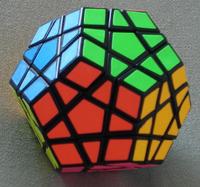 W
WThe Megaminx or Mégaminx is a dodecahedron-shaped puzzle similar to the Rubik's Cube. It has a total of 50 movable pieces to rearrange, compared to the 20 movable pieces of the Rubik's Cube.
 W
WThe Minus Cube is a 3D mechanical variant of the n-puzzle, which was manufactured in the Soviet Union. It consists of a bonded transparent plastic box containing seven small cubes, each glued together from two U-shape parts: one white and one coloured. The length of one side of the interior of the box is slightly more than twice the length of the side of a small cube. There is an empty space for one small cube inside the box, and the small cubes are moveable inside the box by tilting the box, causing a cube to fall into the space. The goal of the puzzle is to shuffle the cubes in such a way that on each side of the box, all of the faces of the small cubes have the same color.
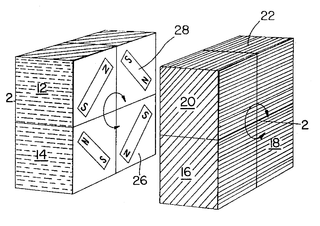 W
WLarry D. Nichols, born 1939 in the United States, is a puzzle designer. He grew up in Xenia, Ohio, and studied chemistry at DePauw University in Greencastle, Indiana, before moving to Massachusetts to attend Harvard Graduate School. He is best known for the invention of mechanical puzzles including 'The Nichols Cube Puzzle' (1974), patent US365520. He has lived with his wife Karen in Arlington, Massachusetts since 1959.
 W
WThe Nintendo tumbler puzzle, also known as the Ten Billion Barrel in English and originally tenbirion (テンビリオン) in Japanese, is a mathematical puzzle in the style of Rubik's Cube. It was invented by Gunpei Yokoi of Nintendo in 1980 and was covered by U.S. Patent 4,376,537 until the patent expired in March 1995 due to non-payment of a maintenance fee.
 W
WPeg solitaire is a board game for one player involving movement of pegs on a board with holes. Some sets use marbles in a board with indentations. The game is known simply as Solitaire in the United Kingdom where the card games are called Patience. It is also called Brainvita.
 W
WThe Puck puzzle, also known as Picture Disc, is a combination puzzle invented in 1980 by Hungarian physicist András Végh. The disc shaped puzzle consists of 2 central pieces: the inner disc, and segments forming a ring around the inner disc. The number of segments is an even number, most commonly six, eight, or twelve. The outer ring can be rotated around the central disc, similar to a wheel being rotated around its axis. The two parts of the central disc can also be rotated, together with the attached ring. With these operations, the combination of the parts can be changed. The goal of the game is to obtain a specific combination, such as forming a picture or ordering the number on the segments.
 W
WA puzzle box is a box that can be opened only by solving a puzzle. Some require only a simple move and others a series of discoveries.
 W
WA puzzle globe is a spherical assembly of puzzle pieces that, when put together, form a complete sphere or globe. Puzzle globes will generally have a one-piece spherical substrate that supports the puzzle pieces as they are laid in place. In some puzzle globes the substrate is steel and the puzzle pieces are magnetic, the magnetic attraction keeping pieces on the lower portion of the sphere from falling off.
 W
WA puzzle jug is a puzzle in the form of a jug, popular in the 18th and 19th centuries. Puzzle jugs of varying quality were popular in homes and taverns. An inscription typically challenges the drinker to consume the contents without spilling them, which, because the neck of the jug is perforated, is impossible to do conventionally.
 W
WA puzzle ring is a jewelry ring made up of multiple interconnected bands, which is a type of mechanical puzzle most likely developed as an elaboration of the European gimmal ring.
 W
WThe Pyraminx is a regular tetrahedron puzzle in the style of Rubik's Cube. It was made and patented by Uwe Mèffert after the original 3 layered Rubik's Cube by Ernő Rubik, and introduced by Tomy Toys of Japan in 1981.
 W
WThe Pyraminx Crystal is a dodecahedral puzzle similar to the Rubik's Cube and the Megaminx. It is manufactured by Uwe Mèffert and has been sold in his puzzle shop since 2008.
 W
WThe Pyraminx Duo is a tetrahedral twisty puzzle in the style of the Rubik's Cube. It was suggested by Rob Stegmann, invented by Oskar van Deventer, and has now been mass-produced by Meffert's.
 W
WThe Pyramorphix, also called Pyramorphinx, is a tetrahedral puzzle similar to the Rubik's Cube. It has a total of 8 movable pieces to rearrange, compared to the 20 of the Rubik's Cube. Though it looks like a simpler version of the Pyraminx, it is an edge-turning puzzle with the mechanism identical to that of the Pocket Cube.
 W
WRubik's 360 is a 3D mechanical puzzle released in 2009 by Ernő Rubik, the inventor of Rubik's Cube and other puzzles. Rubik's 360 was introduced on February 5, 2009 at the Nürnberg International Toy Fair ahead of its worldwide release in August.
 W
WRubik's Clock is a mechanical puzzle invented and patented by Christopher C. Wiggs and Christopher J. Taylor. The Hungarian sculptor and professor of architecture Ernő Rubik bought the patent from them to market the product under his name. It was first marketed in 1988.
 W
WRubik's Magic, like Rubik's Cube, is a mechanical puzzle invented by Ernő Rubik and first manufactured by Matchbox in the mid-1980s.
 W
WRubik's Magic, like Rubik's Cube, is a mechanical puzzle invented by Ernő Rubik and first manufactured by Matchbox in the mid-1980s.
 W
WA Rubik's Snake is a toy with 24 wedges that are right isosceles triangular prisms. The wedges are connected by spring bolts, so that they can be twisted, but not separated. By being twisted, the Rubik's Snake can be made to resemble a wide variety of objects, animals, or geometric shapes. Its "ball" shape in its packaging is a non-uniform concave rhombicuboctahedron.
 W
WRush Hour is a sliding block puzzle invented by Nob Yoshigahara in the 1970s. It was first sold in the United States in 1996. It is now being manufactured by ThinkFun.
 W
WA secret decoder ring is a device which allows one to decode a simple substitution cipher - or to encrypt a message by working in the opposite direction.
 W
WThe Skewb Diamond is an octahedron-shaped combination puzzle similar to the Rubik's Cube. It has 14 movable pieces which can be rearranged in a total of 138,240 possible combinations. This puzzle is the dual polyhedron of the Skewb. It was invented by Uwe Meffert, a German puzzle inventor and designer.
 W
WThe Skewb Ultimate, originally marketed as the Pyraminx Ball, is a twelve-sided puzzle derivation of the Skewb, produced by German toy-maker Uwe Mèffert. Most versions of this puzzle are sold with six different colors of stickers attached, with opposite sides of the puzzle having the same color; however, some early versions of the puzzle have a full set of 12 colors.
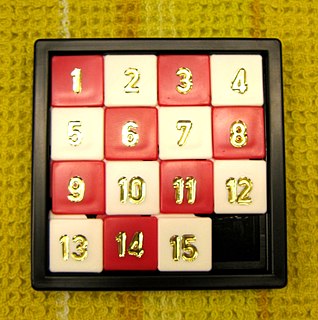 W
WA sliding puzzle, sliding block puzzle, or sliding tile puzzle is a combination puzzle that challenges a player to slide pieces along certain routes to establish a certain end-configuration. The pieces to be moved may consist of simple shapes, or they may be imprinted with colors, patterns, sections of a larger picture, numbers, or letters.
 W
WA snapper is a mechanical puzzle consisting of a pointed piece attached to a notched dowel and a hollow block with a secondary hole along its length through which a rubber-band is stretched and tied off. A demonstrator inserts the dowel into the hollow block, hooks the rubber-band on the notch, pulls on the pointed end, and allows the dowel to snap back into place. The demonstrator hands the puzzle to an observer who cannot hook the rubber-band onto the dowel's notch. The demonstrator takes the puzzle back and makes it snap immediately. The trick is that the ends of the dowel are tapered so that the demonstrator can squeeze the fingers holding it together, causing it to snap into the block.
 W
WStave Puzzles is an American jigsaw puzzle company located in Norwich, Vermont. The company was started in 1974 by Steve Richardson and Dave Tibbetts and was called Stave—a portmanteau of their first names. They manufacture hand cut jigsaw puzzles made from cherry-backed, 5-layered, 1⁄4-inch (6.4 mm) wood. Stave produces several different puzzles types ranging from traditional puzzles, teaser puzzles which can have many open areas within the puzzles, trick puzzles in which the puzzles can be put together in two or more ways of which only one is correct. They also create three-dimensional puzzles, limited edition puzzles, and complete custom puzzles. Each puzzle is provided in a green and blue box and does not include a picture of the completed puzzle. Stave Puzzles is the largest hand-cut jigsaw puzzle company in the United States and competes with laser-cutting companies like Liberty Puzzles and Artifact Puzzles.
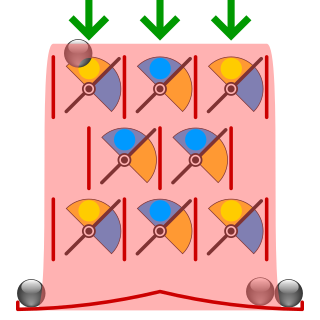 W
WThe Think-a-Dot was a mathematical toy invented by Joseph Weisbecker and manufactured by E.S.R., Inc. during the 1960s that demonstrated automata theory. It had eight coloured disks on its front, and three holes on its top – left, right, and center – through which a ball bearing could be dropped. Each disk would display either a yellow or blue face, depending on whether the mechanism behind it was tipped to the right or the left. The Think-a-Dot thus had 28=256 internal states. When the ball fell to the bottom it would exit either to a hole on the left or the right of the device.
 W
WThe Tower of Hanoi is a mathematical game or puzzle consisting of three rods and a number of disks of various diameters, which can slide onto any rod. The puzzle begins with the disks stacked on one rod in order of decreasing size, the smallest at the top, thus approximating a conical shape. The objective of the puzzle is to move the entire stack to the last rod, obeying the following rules:Only one disk may be moved at a time. Each move consists of taking the upper disk from one of the stacks and placing it on top of another stack or on an empty rod. No disk may be placed on top of a disk that is smaller than it.
 W
WThe Tower of Hanoi – Myths and Maths is a book in recreational mathematics, on the tower of Hanoi, baguenaudier, and related puzzles. It was written by Andreas M. Hinz, Sandi Klavžar, Uroš Milutinović, and Ciril Petr, and published in 2013 by Birkhäuser, with an expanded second edition in 2018. The Basic Library List Committee of the Mathematical Association of America has suggested its inclusion in undergraduate mathematics libraries.
 W
WA Tuttminx is a Rubik's Cube-like twisty puzzle, in the shape of a truncated icosahedron. It was invented by Lee Tutt in 2005. It has a total of 150 movable pieces to rearrange, compared to 20 movable pieces of the Rubik’s Cube.
 W
WThe Wentworth Wooden Jigsaw Company manufactures jigsaw puzzles with 'whimsical' shaped pieces reflecting the theme of the image portrayed on the puzzle. It was founded in 1994 by Kevin Wentworth Preston and is based in the village of Pinkney near Malmesbury, Wiltshire, an area of England known as the Cotswolds.